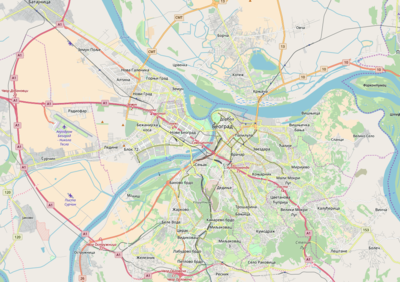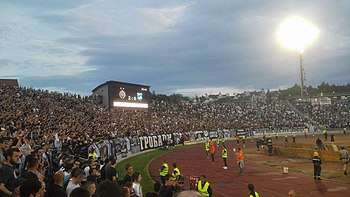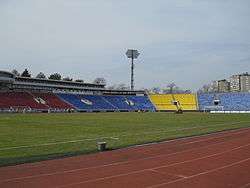Partizan Stadium
The Partizan Stadium (Serbian: Стадион Партизанa, romanized: Stadion Partizana) is a football and track-and-field stadium in Autokomanda, municipality of Savski Venac, Belgrade, Serbia, which has a seating capacity of 29,775. Situated on the Topčider Hill at Humska 1 street, it is a home field of Partizan Belgrade.[2] Also, it was the home of Partizan's main rival Red Star Belgrade from 1959 to 1963, when they moved to the Rajko Mitić Stadium.
 Look on Partizan Stadium | |
 Partizan Stadium Location within Belgrade | |
| Full name | Partizan Stadium |
|---|---|
| Former names | JNA Stadium (1951–1989) |
| Location | Autokomanda, Belgrade, Serbia |
| Coordinates | 44°47′19.48″N 20°27′32.75″E |
| Owner | Partizan Belgrade[1] |
| Operator | Partizan Belgrade |
| Type | UEFA Category 3 Stadium |
| Capacity | 29,775 (football)[2] 40,000 (concerts) |
| Field size | 105 m × 68 m (344 ft × 223 ft) |
| Surface | grass |
| Scoreboard | LED |
| Construction | |
| Built | 1948–1951 |
| Opened | 22 December 1951[1] |
| Renovated | 1998, 2010, 2014, 2015 |
| Architect | Mika Janković |
| Tenants | |
| Partizan Belgrade (1949–present) Red Star Belgrade (1960–1963) Serbia national football team | |
It carried the name JNA Stadium (Serbian: Стадион ЈНА (Стадион Југословенске народне армије) / Stadion JNA (Stadion Jugoslovenske narodne armije)) for a long time and was the site of Youth Day parade. Even today, the majority of football fans in all countries of the former SFR Yugoslavia call it by its old name. Partizan fans, the Grobari, call it also Fudbalski hram (English: The Temple of Football). The stadium has four stands: the south, north, west and east. Before conversion to an all-seater stadium, the ground had a capacity of 50,000 people.
There were plans to replace the current stadium with a new one. Swiss companies Mob Lab and Marazzi-Paul presented a project of a 38,000 seated stadium with commercial contents.[3] The construction was supposed to start in 2006 but it was postponed and later cancelled.
History
Construction of the stadium was started after World War II, on the site of BSK Stadion, which was a 25,000 seat stadium that hosted the Yugoslav national team as well as BSK Beograd. The stadium was built with the help of the Yugoslav People's Army, in the period between 1948 and 1951. Although the stadium was not completely finished, the first match was Yugoslavia against France on 9 October 1949, which ended 1–1. The ground was officially opened on Yugoslav People's Army Day, on 22 December 1951.[1]
From 1957 to 1987 the stadium was the site of Youth Day parade. Every year on 25 May the Relay of Youth were held in Socialist Federal Republic of Yugoslavia. Participants carried a baton with a birthday message to President Josip Broz Tito. The Relay of Youth was a symbolic relay race which started in Tito's birth town Kumrovec and went through all major towns and cities of the country and it ended in Belgrade at JNA Stadium.[4] On 1 April 1957, the stadium received its first electronic scoreboard. First time it was used on a match between Partizan and Vardar Skopje on 30 November 1957.[1]
The stadium was a site of the 7th European Athletics Championship which was held from 12 to 16 September 1962.
In April 1989, Partizan Belgrade purchased the stadium from the former Yugoslav People's Army, and thus became the owner. The name of the stadium were officially changed in Partizan Stadium.[1] Partizan stadium had a 50,000 capacity before the new UEFA security regulations came in effect. There were 15,924 seats, 33 000 standing places and 585 box seats. It was renovated in 1998, and has had a capacity of 29,775 since.[2]
The stadium hosted Partizan in their first-ever UEFA Champions League, the 2003-04 edition. In the qualifiers they eliminated Bobby Robson's Newcastle United; losing 0–1 in Belgrade, but in rematch at St James' Park they won by Ivica Iliev's goal in regular time and reached the group stages after a penalty shoot-out.[5] Despite being drawn in a tough group with Real Madrid (the previous year's Champions League semi-finalist), Porto (the winner of the 2002–03 UEFA Cup and the eventual winner of the competition) and Marseille (the eventual runners-up of the 2003–04 UEFA Cup).,[6] the stadium proved a tough ground for the opposition and the team did not lost a home game, playing out a 0–0 draw with Real Madrid's famous Galácticos, which included players such as Zinedine Zidane, Ronaldo, Luís Figo, Roberto Carlos, Raúl and David Beckham; a 1–1 draw with Porto, led by coach José Mourinho; and Marseille, with its superstars Fabien Barthez and Didier Drogba, while playing some inspired football in the away matches at Madrid (0–1), Marseille (0–3) and Porto (1–2).
In September 2010, Partizan stadium was reorganized in a few places for the UEFA Champions League. Due to UEFA stadium standards, the fences on the eastern and western stands were shortened from 2.25m to 0.70m. The football pitch was extended by 1 square meter. New, modern goal-posts were mounted, and brand new media boxes were constructed on top of the western stand.[7] Partizan's Champions League game against Arsenal on 20 September, was almost postponed due to two of the stadium's floodlights failing. However one of them was fixed and the referee, Wolfgang Stark gave consent for the match to be played with only 3 floodlights.[8]
In March 2012, the old scoreboard was replaced with a new LED display after 55 years of service.[9] On 7 September 2012, Partizan Belgrade announced a sponsorship agreement between the Carlsberg Group and the club, which includes also the placement of black and white chairs on the whole stadium.[10]
Structures and facilities

The Partizan Stadium has 29,775 seats split between four stands: the south, north, west and east. The stands have a height of 21 metres (69 ft) and a span of 236 metres (774 ft) in length (north-south) and 150 metres (490 ft) in width (east-west). There are 30 rows of seats and 30 entry and exit gates for spectators. The playing field measures 105 by 68 metres (344 ft × 223 ft), and is illuminated at 1,400 lux (Philips).[2] The stadium has athletic trace, two grass fields, a training court with locker rooms, press center and restaurant. Within the stadium complex is also 18 tennis courts, boxing hall, shooting range, gym, medical center and commercial area.[2]
Proposed new stadium
In 2006, the current stadium was to be redesigned by Swiss firm Mob Lab. The capacity of the new Partizan stadium would have been approximately 38,000 seats with a modern business park filled with hotels, office buildings, tennis courts and multiplex cinema.[3]
Other uses
Beside sport events, the stadium is also a place for various concerts and shows. The stadium facilities and acoustics meet demands of local artists and international superstars.
- Bijelo Dugme headlined a day-long event, called "Rock spektakl '79", at the stadium on 22 September 1979. Other acts to appear on the day were YU grupa, Galija, Siluete, Generacija 5, Parni Valjak, Suncokret, Prljavo Kazalište, Tomaž Domicelj, Obećanje Proljeća, Metak, Revolver, Prva Ljubav, Senad od Bosne, Opus, Čisti Zrak, Aerodrom, Peta Rijeka, Formula 4, Mama Rock, Kako, Rok Apoteka, Kilo i po, and Crni Petak.
- Metallica performed at the stadium during their Madly in Anger with the World Tour on 15 June 2004, with Van Gogh as the opening act, in front of approximately 25,000 people.[11]
- AC/DC performed at the stadium during their Black Ice World Tour on 26 May 2009, with Amajlija and The Answer as their opening acts, in front of approximately 40,000 people.[12]
See also
Gallery
 Front of the northern stand
Front of the northern stand Front of the southern stand
Front of the southern stand Main Entrance
Main Entrance Western and northern stand
Western and northern stand Cathedral of Saint Sava and Partizan Stadium
Cathedral of Saint Sava and Partizan Stadium
References
- "Crno-bele koči dozvola da izgrade novi stadion" (in Serbian). novosti.rs. Retrieved 18 March 2013.
- "STADIUM". partizan.rs. Retrieved 14 April 2020.
- Mob Lab (27 June 2008). "Partizan's New Stadium Project". Retrieved 12 March 2013.
- "STADIUM... DURING THE CELEBRATION OF THE YOUTH DAY (MAY 25)". Belgrade City Museum. Archived from the original on 16 April 2013. Retrieved 18 March 2013.
- "Njukasl snažno pogođen pobedom Partizana 0:1" (in Serbian). bbc.co.uk/sr. Retrieved 14 September 2012.
- "Partizan sa Realom, Portom i Marsejom! (raspored)" (in Serbian). b92.net. Retrieved 14 September 2012.
- "Za dve decenije u rekonstrukciju Partizanovog stadiona uloženo 15 miliona evra" (in Serbian). The Politika. Retrieved 30 September 2012.
- https://www.telegraph.co.uk/sport/football/competitions/champions-league/8030493/Partizan-Belgrade-1-Arsenal-3-match-report.html
- "Postavljen novi semafor na stadionu Partizana (VIDEO)" (in Serbian). zurnal.rs. Retrieved 18 March 2013.
- "Stadion Partizana dobija crno-bele stolice" (in Serbian). The Sportal. Archived from the original on 11 November 2012. Retrieved 26 November 2012.
- "Metallica na JNA". Svet Gitara (in Serbian). Retrieved 10 January 2020.
- Novakovic, Aleksandar. "Rok zemljotres zvani AC/DC". Blic (in Serbian). Retrieved 10 January 2020.
External links
| Wikimedia Commons has media related to Partizan Stadium. |
- About the Stadium at club official website.
| Preceded by Olympic Stadium Stockholm |
European Athletics Championships Main Venue 1962 |
Succeeded by Népstadion Budapest |